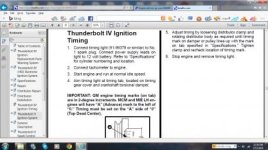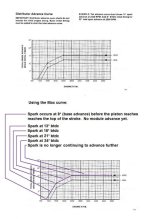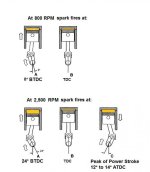MCM (Sterndrive) Model MCM 4.3L ALPHA /BRAVO
MCM 4.3LH ALPHA / BRAVO
MCM 4.3L EFI ALPHA /BRAVO
Propshaft Horsepower
(SAV1 Rating)
190 205 (190)2 2101 (188)2
Propshaft Kilowatts (SAV1 Rating) 142 153 (142)2 1571 (146)2
Number of Cylinders V-6
Displacement 262 cid (4.3 l)
Bore / Stroke - in. (mm) 4.0 x 3.48 (101.6 x 88.4)
Compression Ratio 9.4:1 9.4:1
Compression Pressure Minimum 100 psi (690 kPa)7
Idle rpm In Neutral3 650 rpm5 600 rpm5
Maximum rpm (at WOT)3 4400-4800 rpm
Oil Pressure (at 2000 rpm) Minimum 30 psi (207 kPa)
Minimum Oil Pressure (at Idle) Minimum 4 psi (28 kPa)
Fuel Pressure (1800 rpm) 3-7 psi (21-48 kPa) 30 psi ( kPa)
Electrical System 12 V Negative (–) Ground
Alternator Rating 55 or 65 amp 8
Minimum Battery Requirements 375 cca / 475 mca / 90 Ah
Firing Order 1-6-5-4-3-2
Spark Plug Type
AC - MR43LTS
Champion - RS12YC
NGK - BPR6EFS
Spark Plug Gap .045 in. (1.1 mm)
Timing (at idle rpm)4 10° BTDC 8° BTDC
Preliminary Idle Mixture 1 1/4 Turns DNA
Thermostat 160° F (71° C)
Notes:
1 Power Rated in Accordance with NMMA (National Marine Manufacturers’ Association) rating procedures.
2 Power Rated in Accordance with SAV1 rating procedures. This rating procedure is used to certify that the
engine complies with “Stage 1” Bodensee and Swiss Regulations. Horsepower differences shown result from
differences in test rpm, allowable test tolerances, and/or installation of special kit components.
3 Measured using an accurate service tachometer with engine at normal operating temperature.
4 Timing must be set using a special procedure as outlined in the appropriate section of this manual. Timing cannot
be properly set using the conventional method.
5 A special procedure must be followed to adjust idle rpm. Consult your Authorized Mercury MerCruiser Dealer
before attempting this procedure.
6 Idle speed on EFI models is not adjustable.
7 Minimum recorded compression in any one cylinder should not be less than 70 percent of the highest recorded
cylinder.
8 Serial Number Break for 65 Amp alternator: OL619083 and above.
Setting Base Ignition Timing
1. Connect timing light (91-99379 or similar) to No. 1 spark plug wire. Connect power
supply leads, if applicable, on light to 12 volt battery.
2. Connect a shop tachometer to engine.
3. Using a jumper wire, connect the ignition system timing lead (PUR/WHT wire) to a good
engine ground (–). This locks the ignition module into the Base Timing Mode.
NOTE: Before starting engine make sure the timing tab and marks on damper are clean.
Chalk or white paint on timing marks may help visibility.
4. Start engine and run at normal idle speed. Allow engine to reach normal operating
temperature.
5. Aim timing light at timing tab, located on the timing gear cover and crankshaft torsional
damper.
6. If adjustment is required, adjust timing by loosening distributor clamp and rotating
distributor body as required until timing mark on damper or pulley lines up with the mark
on tab specified in “Specifications.” Tighten clamp and recheck location of timing mark.
7. Make sure that the distributor has been tightened. Remove the jumper wire from the
timing terminal.
8. Remove jumper wire between the timing lead (PUR/WHT wire) and ground (–).
IMPORTANT: Be sure to disconnect the jumper wire from between the ignition system
timing lead and ground (–) before attempting to resume normal operations. If the
jumper wire is left in place, the ignition module will operate in the Base Timing Mode.
This means that the additional timing advance features would not function.
9. Stop engine and remove timing light.
Model 4.3L / 4.3LH 4.3L EFI
Spark Plug Gap .045 in. (1.1 mm)
Spark Plug Type
AC-MR43LTS
NGK-BPR6EFS
Champion RS12YC
Acceleration Spark Advance
This feature is active during acceleration only. When accelerating, the ignition module may
add more spark advance to the “Base Spark Timing Curve”. The amount of spark advance
added, is totally dependant on how fast rpm increases (how fast the throttle is moved). This
feature is also active within a certain rpm range. This range may be slightly different from
one engine model to another. The approximate rpm range for this feature is 1200-4000 rpm.
Within this range, the module can add approximately 10 degrees of spark advance to the
base spark timing curve.
Mean-Best-Timing (MBT) Spark Advance
During light load cruising, the ignition module searches for the optimal ignition timing. This
is also accomplished by small changes to the spark advance. At a given rpm, the module
will try to add a small amount of advance and wait to see if there is an rpm change. If rpm
increases, it will try to increase timing more. The module will continue to advance timing until
it no longer gets an increase in rpm. Conversely, if it senses an rpm drop, it will start to retard
some of the spark timing. The approximate rpm range for this feature is 1200-4000 rpm.
Within this range, the ignition module can add approximately 10-15 degrees of spark
advance to the base spark timing curve.
NOTE: The Audio Warning System is also connected into the ignition module circuit. If the
audio warning system becomes activated by the closing of one of the audio warning system
switches, the MBT feature is deactivated.
Over-Speed Control
The ignition module will prevent the engine speed from exceeding a preset limit by stopping
the spark. This feature has an rpm range that varies from model to model. The over-speed
limit for a particular engine is set slightly higher than the top end of the rpm range for that
model. For example, if the recommended range is 4600-5000 rpm, the over-speed limit
would be set at 5100 rpm. When rpm reaches this limit, spark is turned-off until engine rpm
drops down to a “Reset rpm”, which would be approximately 4750 rpm for this example. At
this point, spark comes back on.
Knock Retard Spark Control
The knock control feature helps provide protection from harmful detonation. Knock control
is handled by the Knock Control Module. This module receives a signal from a sensor that
is mounted on the engine block. The knock control module works in conjunction with the
ignition module to retard the timing if spark knock is present.
IMPORTANT: The graph below shows the typical advance ranges for a Thunderbolt
V ignition control module. The numbers plotted on the graph are not representative
of any particular model. It is only presented to provide an understanding of how the
system functions.
Based on the timing graph in the manual with a base timing of 0 you should reach max timing 25 degrees before top dead center +/- 10 degrees by 1800 rpms.
The + is (Acceleration advance range) and ( MTB mean best timing)
The - would be (knock control spark range) meaning if a knock is sensed by the knock sensor the timing will retard up to 10 degrees or so.
so if base is set to 8 BTDC then max should be 33 btdc at or by 1800 rpms if no knock is detected.
= Base Timing Advance Curve
= Idle Speed Advance Range
= Knock Retard Range
= Acceleration Advance Range
= MBT Advance Range





